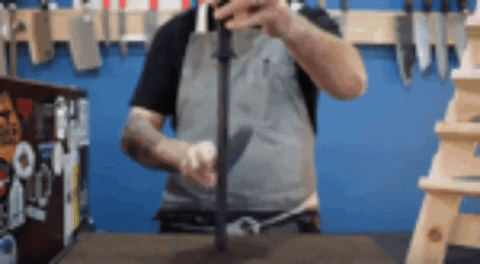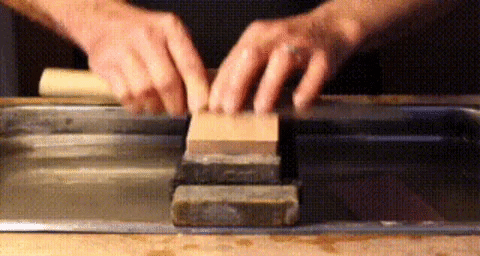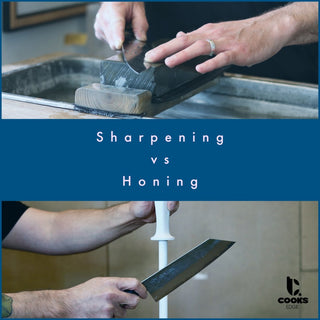One of the most common questions asked at the shop is "what is the difference between honing knife and sharpening your knife?"
This is a fantastic question, because there is a lot of misunderstanding when It comes to both topics. Simply put, we like to refer to "honing" as realigning the edge of your knife, and "sharpening" happens when we remove material to expose new steel.
On honing:
Honing your knife should be done regularly as you use your knife. As a professional chef, I would hone my knife before I started any job on the cutting board. I would even hone in the midst of cutting a lot of something to ensure the blade's edge is always aligned.
When honing your knife, we highly recommend using a ceramic rod over a steel or diamond rod. Steel rods tend to be made with soft steel and usually have ridges, both of these factors can actually dull your knife rather than fix it. Diamond rods are very aggressive, and can potentially remove steel rather than realign. Use either a course or fine ceramic depending on the type of steel your knife is constructed with. Most European or Western knives are made with soft steel, so we recommend using a coarse ceramic rod like the white ones we carry. For Japanese knives, or any forged knife with steel rated over 60 HRC, we recommend using a fine ceramic rod like the black ones we carry.
Starting at the heel of your knife, run the knife down the rod to the tip using a light amount of pressure. Repeat this process 4-6 times per side. Viola! If your knife still isn't cutting properly after you hone it, that's a good sign you need to sharpen it on a whetstone.

On Sharpening:
Sharpening your knives should be done frequently. Whether you get them professionally done or do it yourself, a regular touch-up to keep them sharp will actually extend the life of your knife. If you let your knives get dull, then you will have to remove more steel, thus shortening the life of your knife.
We recommend having at least 3 whetstones to get the job done. A coarse stone to remove fatigued and damaged steel, and set a bevel. A medium stone to smooth out the bevel, and a fine stone for silky smooth cutting and great edge retention.
To sharpen your knife, you must rub your knife back and forth on the whetstone holding a consistent angle until a burr is formed on the opposite side. Flip the knife over and repeat the process, forming a burr on the other side. Then finally stropping the knife on leather or suede for blazing sharp edges.

Thank you for reading. For any questions, comments or inquiries contact info@thecooksedge.com or call 902-370-2470


 is here! Shop now, pay later in 4 easy installments
is here! Shop now, pay later in 4 easy installments